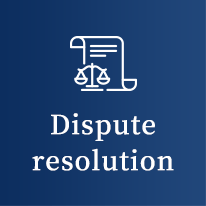Compulsory Execution and Title of Obligation
What is Compulsory Execution?
Compulsory execution is a procedure for forcibly realizing an obliger’s private law claim against the obligor using state power. There are two types of compulsory execution: monetary execution and non-monetary execution. Execution against real estate, execution against movable property, and execution against claims are classified as monetary execution. When an obligor does not comply with a court order, direct enforcement can be used to directly collect a claim or forcibly vacate real estate. Non-monetary execution includes the constructive manifestation of declaration of intention, execution of an act or omission (substituted execution), and execution of a claim for delivery of property. Even if an obligor is compelled to declare his/her intention, he/she may not declare his/her intention, in which case the execution will assume that he/she has declared his/her intention. In addition, if the obligor fails to perform an obligation of action, the obligor can be ordered to pay a certain amount of money during the period of continued nonperformance as indirect compulsion.
Execution of Claims
Debt enforcement is a procedure to seize claims held by the debtor on the debtor’s savings account receivables, accounts receivable, loans, etc., and in the case of individuals, on their salaries and deposits. In this case, the debtor’s debtor is called the third party debtor. The third party debtor is the bank if the debtor has a claim to a bank deposit, the business partner if the debtor has a claim to accounts receivable, or the payer if the debtor has a claim to salaries. First, a petition for an order of attachment of claims is filed with the court. Specifically, a petition, an inventory of parties, an inventory of claims, an inventory of claims to be seized, a title of obligation with a writ of execution attached, and a certificate of service are to be submitted. Once the petition is accepted, the third party debtor is prohibited from paying the debtor. The creditor has the advantage of being able to deal with the third-party debtor on behalf of the debtor, thus enabling prompt collection. Unlike real estate, where the debtor’s ownership can be confirmed by registration, it is difficult to identify to whom and what kind of claim the debtor has, and a seizure on a savings account may result in the claim not being fully collected, since the amount seized is only the amount remaining in the account at the time the seizure order is served. As for wages, once a garnishment is made, it is possible to garnish the wages thereafter, but only up to one-fourth of the amount can be garnished.
Real Estate Execution
Compulsory execution against land or buildings in the debtor’s name. Although it has the merit of making it easier to collect claims, it also has the problem that it takes time to conduct a price survey of the real estate and to conduct an auction procedure, and also the problem that the real estate owned by the counterparty (debtor) is often mortgaged by a bank or other party, and the mortgagor receives priority in receiving dividends, making it impossible to collect his/her own claims. The real estate execution petition is a petition for execution against real estate. A petition for real estate execution is filed with the court having jurisdiction over the real estate, attaching a written petition, a title of obligation with a certificate of execution, a certificate of delivery, registration of the real estate subject to auction, a certificate of qualification or address, a certificate of valuation, and a drawing of the subject real estate. The cost of revenue stamps (4,000 yen), registration and license tax (4/1,000 of the amount of the claim), and prepayment of civil execution (900,000 yen) are required. The court investigates of the real estate and puts it up for auction. The creditor will receive a dividend from the proceeds of the sale.
Execution against Movable Property
This is a procedure to seize goods, machinery, household goods, cash, etc. owned by the debtor. The advantages of this procedure are that it is faster than real estate seizure, and it puts more pressure on the debtor since the bailiff actually comes to the home or company store to seize the property. On the other hand, since leased property cannot be seized, it is difficult to seize expensive company machinery if it is leased, and cash can only be seized up to 600,000 yen. For movable property execution, a petition is filed by submitting to the court a petition for movable property execution, a certificate of qualification, a title of obligation, and a list of parties. Thereafter, a meeting is held with a bailiff to make arrangements for seizure, and seizure is carried out by designating the property from those found as a result of on-site investigation by the execution. The seized property is sold and the proceeds from the sale are applied to the claim.
Title of Obligation
It is said that the execution is to be carried out based on an authenticated copy of a title of obligation with execution power. A title of obligation is a document listed in each item of Article 22 of the Law and is a document that gives the execution agency a basis to initiate an execution act. When carrying out a compulsory execution procedure, it is necessary to prepare a document (judgment document, notarized deed, etc.) that notarizes the existence of the creditor’s right to claim benefits through a lawsuit or other procedure in advance, and these documents are called title of obligation. If the execution agency (execution court or court execution officer) were to investigate the existence or nonexistence and contents of the claim in each case by itself, the speed of execution would be seriously impaired. Therefore, the Execution Law requires a title of obligation prepared by another agency (court or notary) for compulsory execution, and compulsory execution can be carried out only based on a title of obligation. For example, if a judgment is made that the obligor must pay 10 million yen to the creditor, and then the obligor voluntarily pays 3 million yen (partial repayment), the rights described in the title of obligation (judgment document) have been changed. In this case, if the creditor demands the payment of 10 million yen and executes a compulsory execution, the debtor can file an objection to the execution procedure. The title of obligation includes the following
(i) Final and binding judgment
(ii) A judgment with a declaration of provisional execution
(iii) Judicial decision against which no appeal may be entered except by filing an appeal
(iv) A demand for payment with a declaration of provisional execution
(v) Disposition by a court clerk to fix the amount of the burden of court costs, etc.
(vi) A notarial deed prepared by a notary for a claim for payment of money, etc., which contains a statement to the effect that the obligor shall immediately submit to compulsory execution (a statement of acceptance of execution)
(vii) A judgment of a foreign court with a final and binding execution judgment
(viii) An arbitration award with a final and binding execution decision
(ix) A judgment that has the same effect as a final and binding judgment
Writ of Execution
A sentence of execution is a notarized statement that is attached to the end of the authenticated copy of the title of obligation after a court clerk or notary examines the existence of enforceability of the title of obligation, eligibility of parties for execution, and fulfillment of conditions regarding claims with conditions. Since the court clerk or notary examines the enforceability of the title of obligation in advance and endorses the enforceability of the title of obligation, the execution court or court execution officer, which is the executing agency, can start execution easily without the need for substantial investigation on the existence or non-existence of a claim and the enforceability of the title of obligation. This is a very convenient way to start execution. The creditor who has obtained a judgment of victory will file a petition for grant of a certificate of execution with the clerk of the court where the title of obligation was obtained. The court clerk will attach a certificate of execution, which is a document authorizing compulsory execution, to the end of the title of obligation. The court clerk will also mail the title of obligation to the obligor and have a certificate of service, which is a document certifying that the title of obligation has been served, prepared. There are three types of writs of execution
(i) Simple execution clause simply notarizes the enforceability of a title of obligation.
(ii) Writ of execution upon fulfillment of conditions: A writ of execution is prepared after confirming the fulfillment of a condition of suspension or arrival of an indeterminate time limit (in cases where the exercise of rights is conditional upon the death of a specific person, the fulfillment of such condition (death of the specific person)).
(iii) Succeeding execution clause: This is a clause of execution when executing against a person who is not the person indicated in the title of obligation as the obligee or obligor. For example, in cases where a judgment has been rendered and general succession (inheritance, merger, etc.) or specific succession (sale and purchase, transfer of claims) has taken place after the conclusion of oral argument in the fact-finding hearing, a succeeding certificate of execution is required.
Executing agency
An execution agency is a state agency in charge of execution procedures. Under Japan’s Civil Execution Law, execution agencies include execution courts and bailiffs. Usually, when we speak of a court, we think of a court that conducts trials and passes judgment, but there is a division within the court that specializes in conducting execution (in the case of the Tokyo District Court, this division is the Civil Division 21). In addition, although a bailiff is a person independent of the court, he or she performs an official role in the execution procedure and is therefore part of the execution agency. The reason for this separation of the judicial organ, which determines the existence of a claim and issues a title of obligation, and the execution organ, which carries out execution procedures based on the title of obligation, is to ensure the prompt and efficient realization of rights in the execution procedure.
Execution-Related Actions
Appeals against execution proceedings will be made through legal proceedings. These lawsuits are called execution-related lawsuits. There are the following types of execution-related lawsuits.
Actions to Oppose a Claim
An action to oppose a claim is a procedure aimed at eliminating the enforceability of a title of obligation by judgment and preventing compulsory execution in cases where a claim is indicated as existing in the title of obligation, but the claim has become nonexistent due to subsequent payment or other reasons. In addition, an action to oppose a claim is used to dispute the validity of a title of obligation other than a judicial decision. Since the purpose of an action to oppose a claim is to eliminate the enforceability of the title of obligation itself, it can be filed after the establishment of the title of obligation, even before the commencement of compulsory execution. It is also possible to file an action to oppose a claim even after the compulsory execution procedure has been terminated.
Actions for Grant of a Writ of Execution
In some cases, it is not possible to prove the fulfillment of a condition or the existence of a succeeding relationship only by a court clerk or a notary public, because it is not possible to submit a document showing the fulfillment of a condition or the existence of a succeeding relationship. In such cases, the action for grant of a writ of execution is to confirm the existence of the special requirements for grant of a writ of execution through a court proceeding. Since the purpose of an action for grant of a writ of execution is to confirm the fulfillment of conditions, etc., the existence or non-existence of the right to claim under the title of obligation is not judged.
Action to Oppose Grant of a Writ of Execution
In cases where a writ of execution to fulfill a condition or a writ of succession has been granted, this is an action to stop execution against the obligor by claiming that the condition has not been fulfilled on his/her part and that he/she is not the successor to the obligation.
Actions to Oppose Third Party
A third-party action against execution is a procedure to exclude execution through court proceedings when compulsory execution is made against the property of a third party to which the title of obligation is not enforceable or against the property of the debtor other than the liable property indicated in the title of obligation, by arguing that the property subject to execution is not part of the liable property. Since the title of obligation does not state the scope of the property liable, it is necessary to judge based on the external facts as to which property can be enforced. If a third-party claims that the property in question is not the debtor’s property but his/her own, the third party must file a third party objection and have the court confirm that the property is not subject to compulsory execution.










